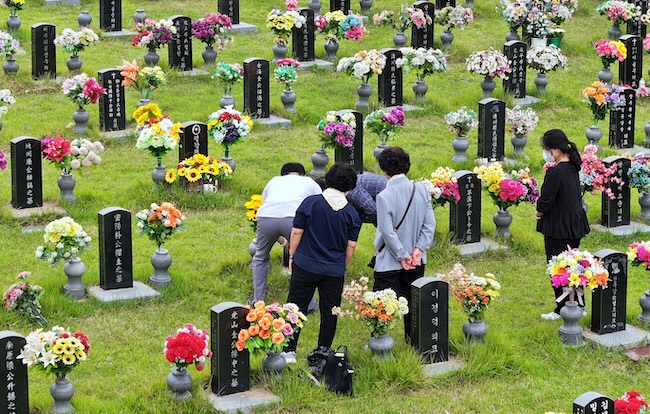
The demand for memorial flowers during each Chuseok holiday is substantial. (Image courtesy of Yonhap)
SEOUL, Oct. 16 (Korea Bizwire) – South Korea boasts a robust post-burial culture steeped in ceremonies held at gravesites during special occasions. As a result, the demand for memorial flowers during each Chuseok holiday is substantial.
However, over time, plastic flowers have gained popularity over their fresh counterparts as the preferred choice for memorial ceremonies.
Unlike fresh flowers that quickly wither, plastic flowers offer several advantages. They are not only more cost-effective but also possess a durability that remains unaffected by weather conditions when placed at a gravesite.
Consequently, plastic flowers have become a common choice for memorial displays in most of the nation’s parks and cemeteries.
Nonetheless, it’s crucial to acknowledge that plastic flowers are, in essence, plastic waste masquerading as floral tributes. Comprising synthetic fibers, plastic, and metal cores, these materials are challenging to recycle due to their composite nature.
Disposing of plastic flowers often involves burial or incineration, processes that yield carbon emissions and fine plastic particles that contribute to environmental pollution—a significant concern.
To compound matters, many plastic artificial flowers are imported from other countries, with yearly imports exceeding 2,000 tons, primarily sourced from China.
A stark example can be seen at Daejeon National Cemetery, where an astounding 449 tons of plastic wreaths have been discarded in the past five years.
According to data from the Ministry of National Defense, the volume of plastic wreaths discarded at Daejeon National Memorial Park reached 95 tons in 2019, 78 tons in 2020, 108 tons in 2021, 92 tons in 2022, and 76 tons as of September of this year. The five-year cost of disposing of these plastic wreaths amounted to 142 million won.
Recognizing the environmental and cultural significance of this issue, the South Gyeongsan Province city of Gimhae, renowned for its flower industry, took a pioneering step by officially implementing a policy banning plastic artificial flowers in parks and cemeteries this year—the first of its kind in the country.
During the recent Chuseok holiday, the city concentrated on raising awareness about the value of fresh flowers within traditional ceremonies by sharing them with visitors to gravesites.
The initiative is gaining momentum and spreading to other jurisdictions, including South Gyeongsang Province as a whole and the city of Busan. As one cemetery visitor aptly stated, “I feel a deeper sense of reverence when I carry fresh flowers compared to artificial ones. I believe this policy is not only culturally significant but also beneficial for the environment.”
M. H. Lee (mhlee@koreabizwire.com)






